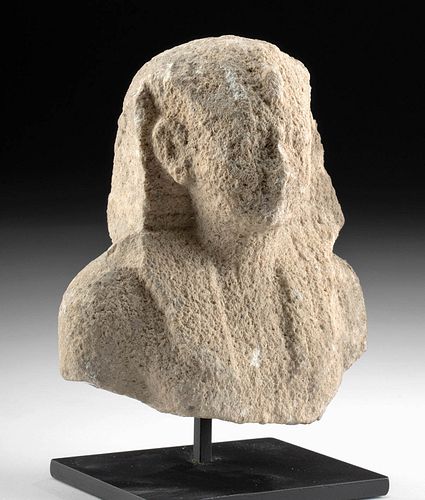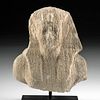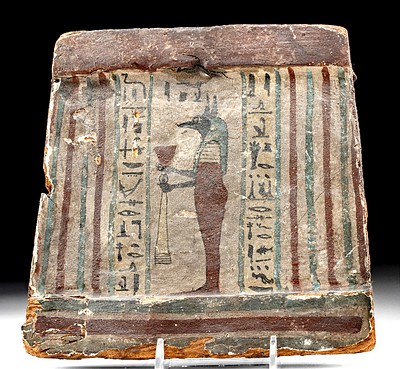Egyptian Limestone Bust of a Pharaoh
Lot 1b
About Seller
Artemis Fine Arts
686 S Taylor Ave, Ste 106
Louisville, CO 80027
United States
Selling antiquities, ancient and ethnographic art online since 1993, Artemis Gallery specializes in Classical Antiquities (Egyptian, Greek, Roman, Near Eastern), Asian, Pre-Columbian, African / Tribal / Oceanographic art. Our extensive inventory includes pottery, stone, metal, wood, glass and textil...Read more
Categories
Estimate:
$26,000 - $39,000
Absentee vs Live bid
Two ways to bid:
- Leave a max absentee bid and the platform will bid on your behalf up to your maximum bid during the live auction.
- Bid live during the auction and your bids will be submitted real-time to the auctioneer.
Bid Increments
| Price | Bid Increment |
|---|---|
| $0 | $25 |
| $300 | $50 |
| $1,000 | $100 |
| $2,000 | $250 |
| $5,000 | $500 |
| $10,000 | $1,000 |
| $20,000 | $2,500 |
| $50,000 | $5,000 |
| $100,000 | $10,000 |
| $200,000 | $20,000 |
About Auction
By Artemis Fine Arts
Aug 26, 2021
Set Reminder
2021-08-26 10:00:00
2021-08-26 10:00:00
America/New_York
Bidsquare
Bidsquare : Fine Antiquities | Asian | Ethnographic Art
https://www.bidsquare.com/auctions/artemis-gallery/fine-antiquities-asian-ethnographic-art-7366
Features classical antiquities, ancient and ethnographic art from cultures encompassing the globe. Egyptian, Greek, Roman, Etruscan, Near Eastern, Asian, Pre-Columbian, Native American, African / Tribal, Oceanic, Spanish Colonial, Russian, Fine / Visual Arts, so much more! Artemis Fine Arts info@artemisgallery.com
Features classical antiquities, ancient and ethnographic art from cultures encompassing the globe. Egyptian, Greek, Roman, Etruscan, Near Eastern, Asian, Pre-Columbian, Native American, African / Tribal, Oceanic, Spanish Colonial, Russian, Fine / Visual Arts, so much more! Artemis Fine Arts info@artemisgallery.com
- Lot Description
Egypt, late Third Intermediate to early Late Dynastic Period, ca. 7th to 6th century BCE. A lovely limestone bust of an imposing pharaoh. He stares forward with faint facial details and protruding ears under a nemes headdress, with the traces of a uraeus on the brow. The face is framed by the striated sides of the headdress, and the lappets hang down to rest on the broad shoulders. The verso of the head is well defined with striations and part of the nemes hanging down the center of his spine. Despite the head's uneven line across the chest, this bust may have been created as a standalone object rather than a piece from a larger statue. It is indefinite who this model was meant to represent, though the refined quality and sophisticated presentation indicates it was likely a pharaoh of this period. Similar pieces are held in the British Museum, the Australian Museum, the Metropolitan Museum of Art, and many other institutions. Such busts may have been models for apprentices to practice this craft. Size: 4.75" W x 5.25" H (12.1 cm x 13.3 cm); 6" H (15.2 cm) on included custom stand.
A carved head like this example may have served as a model for a larger sculpture, to teach apprentice sculptors how to replicate a master style, or to produce ushabti figures (small funerary statues for tombs). Though sculptors' models are typically difficult to date - with some being from the Amarna period of the 18th Dynasty when new forms of statuary came in - most known examples are from the Late Dynastic and Ptolemaic periods. The Egyptians were keen observers of fauna, with many different animals gracing their mythology, artwork, and hieroglyphs; however, anthropomorphic models were typically among the most challenging to carve accurately.
While sculptors' models appear to be from larger composite figures, their incomplete presentation could be an entirely separate item typology. Ancient Greek sculptural incompleteness was a generic form of presentation as the viewer could extrapolate who or what a sculpture was meant to represent. In contrast, the ancient Egyptians would view an incomplete votive work of art only as it was: part of a bird, a disembodied head, or in one instance the hind quarters of a lion. According to Eric Young of the Metropolitan Museum of Art, "When we consider the Egyptian pieces as sculptors' models, however, their incompleteness is no longer disturbing, but entirely understandable. As is the case with unquestioned sculptors' models...the apprentice sculptor concentrated his energies on those portions of the figure that he found intriguing, or most difficult, and the master sculptor demonstrated the correct way to delineate a head…" ("Sculptors' Models or Votives? In Defense of a Scholarly Tradition." The Metropolitan Museum of Art Bulletin, March 1964, p. 255).
This piece has been searched against the Art Loss Register database and has been cleared. The Art Loss Register maintains the world’s largest database of stolen art, collectibles, and antiques.
Provenance: private New York, USA collection; ex-private collection, acquired in the 1960s and imported to the United States in the late 1980s
All items legal to buy/sell under U.S. Statute covering cultural patrimony Code 2600, CHAPTER 14, and are guaranteed to be as described or your money back.
A Certificate of Authenticity will accompany all winning bids.
PLEASE NOTE: Due to recent increases of shipments being seized by Australian & German customs (even for items with pre-UNESCO provenance), we will no longer ship most antiquities and ancient Chinese art to Australia & Germany. For categories of items that are acceptable to ship to Australia or Germany, please contact us directly or work with your local customs brokerage firm.
Display stands not described as included/custom in the item description are for photography purposes only and will not be included with the item upon shipping.
#164985Fragment of a larger piece as shown. Loss and abrasions to left side of headdress. Softening and weathering of details. Light mineral and earthen deposits.Condition
- Shipping Info
-
All shipping is handled in-house for your convenience. Your invoice from Artemis Gallery will include shipping calculation instructions. If in doubt, please inquire BEFORE bidding for estimated shipping costs for individual items.
-
- Buyer's Premium



 EUR
EUR CAD
CAD AUD
AUD GBP
GBP MXN
MXN HKD
HKD CNY
CNY MYR
MYR SEK
SEK SGD
SGD CHF
CHF THB
THB














